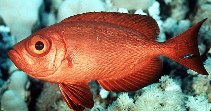| Family: |
Priacanthidae (Bigeyes or catalufas) |
| Max. size: |
45 cm TL (male/unsexed) |
| Environment: |
reef-associated; marine; depth range 0 - 250 m |
| Distribution: |
Indo-Pacific: Red Sea and southern Africa to French Polynesia, north to southern Japan, south to Australia. Reported from Easter Island (Ref. 33390). |
| Diagnosis: |
Dorsal spines (total): 10-10; Dorsal soft rays (total): 13-15; Anal spines: 3-3; Anal soft rays: 13-16. This species is distinguished by the following characters: body depth 2.5-2.9 in SL; poorly developed preopercular spine, reduced or inconspicuous to non-existent in adults (> 12.5 cm TL); total gill rakers in first gill arch 24-26; soft portion of dorsal fin taller than spinous portion, angular posteriorly; pectoral fins shorter than pelvic spine; pelvic fins long, reaching posterior to spinous portion of anal fin; distinctly emarginate caudal fin; scales modified, the posterior field elevated as a separate flange with spinules both on surface and posterior margin; vertical scale rows (dorsal-fin origin to anus) 48-57; swimbladder with pair of anterior and posterior protrusions. Colour of body entirely red or capable of quickly changing to silvery with about 6 red bars or large spots on upper side (dusky spots evident on dorsal and anal fin in blotchy or barred fish); membranes of caudal and pelvic fins blackish distally (Ref. 54980, 68288, 90102). |
| Biology: |
Uncommon species found in outer reef slopes and deep lagoon pinnacles from 8 to at least 80 m. In small aggregations, sometimes schools in oceanic locations (Ref. 48635). Also found under ledges or hovering next to coral heads during day (Ref 90102). Feeds on small fish, crustaceans, and other small invertebrates (Ref. 5213). Occasionally taken in moderate numbers in trawls and by hook-and-line (Ref. 68288). Generally marketed fresh, may be salted or dried (Ref. 5284). Minimum depth reported taken from Ref. 128797. |
| IUCN Red List Status: |
Least Concern (LC); Date assessed: 10 March 2015 Ref. (130435)
|
| Threat to humans: |
harmless |
Source and more info: www.fishbase.org. For personal, classroom, and other internal use only. Not for publication.

